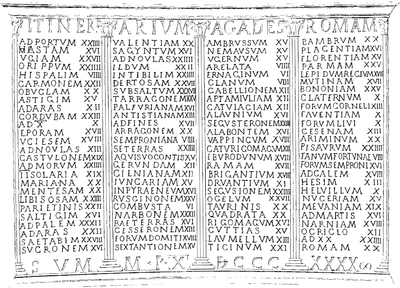Vicarello Cups

The Vicarello Cups are four silver cups discovered in 1852 near the baths of Aquae Apollinares, at Vicarello, Italy, near Lake Bracciano.
History
The cups were discovered in 1852 when the existing bath complex near Vicarello was destroyed to create a more modern one. The cups were found inside a crevice in the rock from which the thermal waters issued, along with a deposit consisting of ca. 5,000 bronze coins (of Greek, Etruscan and Roman origin, including ca. 400 kilograms (880 lb) of aes rude), 34 vessels (3 of gold, 25 of silver, 6 of bronze) of which 12 were inscribed (including the cups themselves), and various metal objects such as plates, small statues in bronze and other materials.
The finds from the deposit, including the cups, are mostly to be found in the Museo Nazionale Romano, while a few of the numismatic finds are in the Vatican Museums. The collection original belonged to the Kircher Museum, which was later incorporated into the Museo Nazionale. It is possible that many of the coins from the original discovery did not make it into the museum collection.
Description
.jpg)
Dated to the 1st century AD, the cups are cylindrical in form and range in height from 9.5–11.5 cm (3.7–4.5 in) and are shaped like Roman milestones. They are inscribed on their outside with an itinerary that goes from Gades (modern Cadiz) over land to Rome, including all the 104 stopping points along the way and the distances between them, for a total of 1840 Roman miles (2,723.2 km (1,692.1 mi)).
Interpretation
The finds are believed to have been part of a votive deposit, consisting of dedications made by the sick who sought a cure at the baths, likely to the protective deity of the location, Apollo.
The presence of the cups with the inscribed itinerary has raised several questions. They do not seem to have any relationship to the divinity of the location and in fact the route on the cups, which includes the Via Flaminia in Italy, does not include Vicarello, instead passing dozens of kilometers to the east, through Narnia (modern Narni) and Ocriculum (modern Otricoli). One hypothesis[1] is that the cups were dedicated to Apollo as a thank offering for the accomplished trip, by merchants from Gades who traveled to Rome for business. This hypothesis does not explain why these merchants would have preferred the much longer land route to the faster and likely less expensive one by sea.
A second hypothesis[2] is that these cups were donated by travelers from Spain to the Roman senator Lucius Junius Caesennius Paetus, a relative of the emperor Domitian who had a villa in the town of Vicarello. These merchants would then later have dedicated the cups to Apollo.
References
- ↑ Università di Bologna - Corso di laurea in storia, insegnamento di storia romana - "Le fonti per lo studio dell'Italia romana"
- ↑ G. Cordiano, Domiziano, Columella e la Stipe di Vicarello, Annali della Facoltà di Lettere e Filosofia, ISSN 0392-9345, Nº 24, 2003
Bibliography
- CIL XI, 3281, 3282, 3283, 3284
- Giuseppe Marchi, La stipe tributata alle divinità delle Acque Apollinari, Roma, 1852
- Jacques Heurgon, La date des gobelets de Vicarello, Bordeaux, Revue des Études Anciennes N.54, 1952
- Ernst Künzl, Susanna Künzl, Aquae Apollinares / Vicarello (Italien), Caesarodunum, N.26, 1992
- Lidio Gasperini, El tesoro de Vicarello. Un gran descubrimiento arqueológico del siglo XIX, Madrid, Gerión ISSN 0213-0181 Vol. 26 núm 2, 2008
Related
External links
- "Images of the Vicarello cups".
- "Image of the Itinerarium Gaditadum on one of the cups".
- "Reconstruction of the stratigraphy of the deposit at Vicarello".
- "Details of the inscriptions".
- "Itinerarium Gaditanum at the BIBLIOTHECA AUGUSTANA".
- "El tesoro de Vicarello. Un gran descubrimiento arqueológico del siglo XIX" (PDF) (in Spanish).